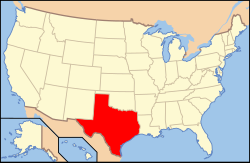Baffin Bay, Texas
| Baffin Bay, Texas | |
|---|---|
 |
|
 |
|
| Location | Kenedy County / Kleberg County, Texas, USA |
| Coordinates | 27°15′21″N 97°30′59″W / 27.25583°N 97.51639°WCoordinates: 27°15′21″N 97°30′59″W / 27.25583°N 97.51639°W |
| Max. length | 23 km (14 mi) |
| Max. width | 3–7 km (2–4 mi) |
| Surface area | 219 km2 (100 sq mi) |
| Average depth | 2.3 m (8 ft) |
| References | |
Baffin Bay is a bay in South Texas, an inlet of the larger Laguna Madre. Located near the Gulf of Mexico, Baffin Bay forms part of the boundary between Kenedy County and Kleberg County.
The history of the bay name is unclear. The most popular story is that Captain Mifflin Kenedy (1818–1895), after visiting the Arctic Baffin Bay as a young man, gave the same name to the bay in Texas because of the remarkable contrast between the bays. The Arctic Baffin Bay is located between the Baffin Island of Canada and Greenland, and it is about 310 times larger by area than the Baffin Bay in Texas.
The Baffin Bay has three branches, which are named as follows (counterclockwise on the map above): Alazan Bay on the north (green), Cayo del Grullo (purple) and Laguna Salada (blue). Several ephemeral streams, including San Fernando, Santa Gertrudis and Los Olmos, flow into the bay, but only when it rains. Because of the scarce freshwater inflow and extensive evaporation, which is promoted by shallow water and warm climate, the bay has a relatively high water salinity reaching 75‰ (parts per thousand) in its northern part. Between 1946 and 1948 and in 1968, the salinity level in the bay exceeded 100‰ killing much fish in the area.
About 21 km2 of the bottom of the bay is covered in seagrass; most other parts are dominated by shoal grass (Halodule beaudettei) with occasional rocky outcrops. Scattered parts of the bay, mostly near the mouth, contain the relict serpulid worm reefs, which are composed of the remains of serpulid tube worms. Although some tube worm species still inhabit the bay area and the reefs, they bring no significant contribution to the reef structure. Most reefs are circular or ellipsoid structures between 8 and 40 meters (26 to 131 ft) in diameter and 0.5 to 2 meters (1.5–6.6 ft) in height above the sediment. Their total area is about 16 km2 (6 mi2), but it is gradually reducing due to erosion.
...
Wikipedia
